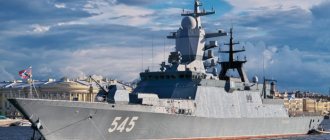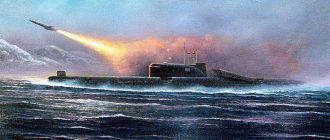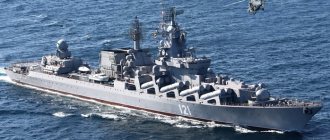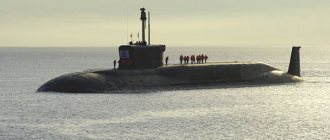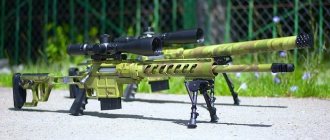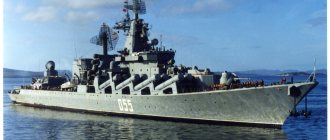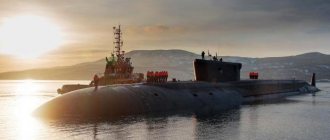Russia will withdraw from its fleet the legendary Soviet Project 667 submarines, which have undergone a record number of modernizations. AiF.ru found out why they stayed in the navy for so long.
Submarines of this type were developed back in the 1960s by the Rubin Central Marine Engineering Design Bureau. The submarines have undergone a record number of upgrades, during which they were armed with new missile systems, more powerful and longer-range. In addition to the 667-BDRM project, nuclear submarines were modernized within the framework of the 667-B, 667-BD and 667-BDR projects. All seven ships of this project were put into operation in the Soviet Union. At the time of the collapse of the USSR, these submarines remained the most modern and formed the backbone of the nuclear forces of the Russian Navy. Project 667 BDRM "Dolphin" is the latest modification of the legendary series; seven ships of this type were built in 1984-1990.
They were called suicide bombers. Russian sailors and their boats at the dawn of the underwater era Read more
Comfortable and silent
When creating the 667-BDRM project, much attention was paid to reducing the noise of the vessel, as well as reducing interference with the operation of hydroacoustic on-board equipment. As a result, the nuclear submarine, in terms of hydroacoustic signature characteristics, has approached the level of the American nuclear submarine with third-generation ballistic missiles "Ohio". Living conditions were also significantly improved. The cruiser has a sauna, solarium, and gym. An improved system of electrochemical air regeneration due to the electrolysis of water and the absorption of carbon dioxide by a solid regenerating absorber ensures a concentration of oxygen within 25% and carbon dioxide - no more than 0.8%.
Submarines of Project 667-BDRM became one of the first Soviet nuclear submarines that were almost completely invulnerable in their combat duty area. During combat patrols in the Arctic seas, which are adjacent directly to the Russian coast, submarines, even under the most favorable hydrological conditions for the enemy, can be detected at distances of no more than 30 km.
Article on the topic
Submarine of Peter I. How a Russian peasant created a combat “hidden ship”
Assembly
To begin with, I demolished all the detail on the deck; there was no way to fix it - since it (like all Alanger models) was convex. I cut everything anew, guided by photographs and drawings. Drilled holes for the pop-up camera, signal buoys and TA. All of this was manufactured from scratch as separate parts. Next, I opened all the scuppers and glued a mesh of etched paper from the inside. Actually, there should have been a grid with 6 holes, but I didn’t have such a small one at hand. Track. step – detailing of the cutting: in the kit it is simply pristinely smooth. I made handrails, doors, cut the sonar fairing. From etching I made the missing side windows, grilles and running lights. On the “roof” I cut hatches for the radio sextant and direction finder. I cut a slot for the Willow. In addition, I drilled seats for the missing PMUs and scuppers. Now the deck. The hatches of the missile containers must consist of two parts, so on those that are closed, I showed this by jointing, and sawed the open ones in half. The “rails” for the safety ends (by the way, what are they called correctly?) were made from thin strips of polystyrene. The bollards on the bow and stern were made of the same polystyrene, but only with a round cross-section. Those at the beginning of the hump were made lowered from the meth. tubes of suitable diameter. Here and there I added etched hatches. And finally, I drilled scupper holes along the entire length. I made the rockets from a sprue. In the lower part of the hull, right under the missile silos, I made protrusions from putty. As I understand it, this was done on the prototype, since the height of the D-9RM missiles did not fit into the body. The reactor water intakes were moved a little lower - in accordance with the drawings. The contours of the body were corrected where possible - by grinding. Almost all of the VUs have been redone - only 2 remain from the set. Some have been made from scratch, some from the remnants of other sets. I used medical needles of different diameters as rods.
Irreplaceable
Project 667-BDRM "Dolphin" strategic missile submarines continue to be the basis of the naval component of Russia's strategic nuclear triad, gradually transferring this role to Project 955 "Borey" submarines. Since 2012, they have been rearmed with improved R-29RMU2.1 “Lainer” SLBMs instead of the previous modification R-29RMU2 “Sineva” missiles. K-18 “Karelia”, K-407 “Novomoskovsk”, K-114 “Tula”, K-51 “Verkhoturye” were re-equipped, K-117 “Bryansk” is undergoing refurbishment. BS-64 "Podmoskovye" has been converted into a carrier of a special-purpose deep-sea vehicle. All operational submarines of this class are part of the 31st submarine division of the Northern Fleet and are based in Yagelnaya Bay, home port - Gadzhievo.
The last two submarines of the earlier project 667-BDR "Kalmar" are still in service: K-44 "Ryazan" as part of the Pacific Fleet, BS-136 "Orenburg" was rebuilt to carry out special missions as a carrier of ultra-small submarines and is part of the special forces Northern Fleet.
Nuclear-powered strategic missile submarine cruiser K-114 "Tula" (left) and nuclear-powered strategic submarine K-535 "Yuri Dolgoruky" at the berth in the village of Gadzhievo, Murmansk region. Photo: RIA Novosti/Pavel Lvov
Electronic weapons[edit | edit code]
The radio-electronic equipment includes:
- BIUS MVU-106 "Almaz-BDR".
- KCVS "Atoll".
- Radar complex MRK-50 “Cascade” (“Snoop Tray”), MRK-57 “Korma”.
- The hydroacoustic complex MGK-400 "Rubicon" ("Shark Teeth"), which is a modernized version of the MGK-300 "Rubin" with a target detection range of up to 200 km and put into service in 1976,
- GAS "Aurora-1", GAS "Shmel" navigation.
- MG-43 - station for measuring the speed of sound under water, MG-33.
- RTR and RR equipment MRP-21A “Zaliv-P” RTR, “Zavesa-P” radio direction finder (Brick Pulp/Group; Park Lamp D/F)
- GPD means 4 x GPD MG-44, MG-34, GIP-1.
- Navigation complex "Tobol-M1" or "Tobol-M2".
- SNS "Cicada", radio sextant (Code Eye), ANN
- Radio communication complex "Molniya-M" (Pert Spring); SSS "Tsunami-BM", towed buoy antennas "Paravan", manufactured towed antenna device "Lastochka" (VLF), HF and microwave antennas, sound underwater communication station.
- Ice reconnaissance equipment "Nok-1" navigational circular detector, "NOR" navigational detector of ice breaks, echo ice meter "EL-3".
- television complexes MT-70, MT-30;
- ship uniform time system "Platan-M"
Records
During the Begemot-2 exercise on August 6, 1991, the submarine’s entire ammunition load of 16 missiles was launched from the K-407 Novomoskovsk nuclear submarine at intervals of 14 seconds. This became a world military-technical record. For comparison: the maximum salvo of the American nuclear submarine Ohio is 4 Trident-2 missiles.
On July 7, 1998, the world's first satellite launch from a submarine took place. The Shtil-1 rocket launched from the K-407 Novomoskovsk nuclear submarine launched two German satellites into low-Earth orbit: Tubsat-N and Tubsat-N1. The launch was carried out from an underwater position. The 70 kg satellite was launched into a circular orbit at an altitude of 400 km. The same launch was repeated by the K-84 Ekaterinburg submarine in 2006.
Armament
Missile silos
Surface launch of a rocket.
Illustration from Soviet Military Power
Rocket
Main article: R-29R
The main armament is the D-9R missile system, which has 16 silo-type launchers. This complex for the first time provided the possibility of combat use of missile weapons from high latitudes. Underwater launch can be carried out at depths of up to 50 meters at a speed of 6 knots. All missiles can be launched in one salvo. The R-29R liquid-fuel missile, using nitrogen tetroxide (amyl) as an oxidizer and asymmetrical dimethylhydrazine (heptyl) as a fuel, is designed to destroy strategic targets at intercontinental ranges with the ability to strike highly protected small-sized (“hard”, defined by the Americans), targets such as ground-based ICBM launchers, command posts, and special ammunition storage bases. Adopted by the Navy in 1977. Main tactical and technical characteristics: Launch weight, t 35.3. Maximum throwable weight, t 1.65. The maximum firing range is intercontinental. The warhead is monoblock and multiple warheads. Number of warheads, pcs. 1, 3, 7 (The R-29R missile carried a MIRV with three warheads with a power of 0.2 mt each and had a maximum range of 6500 km. The R-29RL was equipped with a monoblock warhead with a power of 0.2 mt. 45 mt and could hit targets at a range of about 9000 km. The R-29RK had the ability to deliver seven warheads (0.1 mt) to a range of up to 6500 km.) The astroinertial control system with full (in direction and range) astrocorrection provided a CEP of about 900 m. Number of steps, pcs. 2. Rocket length, m 14.1. Rocket diameter, m 1.8. The fuel is liquid.
Torpedo
The ship's torpedo armament consists of four 533-mm and two 400-mm torpedo tubes with an air-fired firing system that allows firing at diving depths of up to 250 meters, and the Kalmar torpedo tube preparation system. The torpedo complex occupies the upper third of the first compartment. Torpedo tubes are arranged in two horizontal rows. In the center plane of the ship, above the first row of TATA, there was a horizontal torpedo-loading hatch. The ammunition load includes 16 torpedoes.
The submarine torpedo 53-65K (anti-ship) was put into service in 1969. Gas turbine, hydrogen peroxide torpedo, caliber 533 mm, length 7.2 m, weight 2070 kg, explosive weight in the warhead about 300 kg, speed 45 knots and range 19 km. Acoustic active homing system with vertical locating of the wake of the target ship, non-contact, active, electromagnetic fuse. The heading device installed in the torpedo ensures that the angle of rotation of the torpedo is set at any point on the trajectory, which allows it to be used at any heading angles of the target from 0° to 180°.
The SET-65 (anti-submarine) submarine torpedo was put into service in 1965. Electric, caliber 533 mm, length of the SET-65 torpedo - 7.8 m, weight 1750 kg. The weight of the explosive in the warhead is about 200 kg. The single-use silver-zinc battery STs-240 provides a speed of 40 knots and a range of 15 km. Acoustic active-passive homing system with a response radius along the active channel of 800 m, a non-contact fuse, circular action, acoustic, active type with a response radius of 10 m. A two-torpedo salvo of these torpedoes with their parallel stroke ensures reliable destruction of a freely maneuvering submarine at firing distances of up to 30-35 cable and diving depths up to 400 m.
Air defense
Air defense is represented by 2 sets of “Strela-2M”.
Frame
K-433
under repair in Bolshoi Kamen
The embedded board is located on the bulkhead between the 3rd and 4th compartments in the area of the upper deck, it is welded into the bulkhead ( mortgage board K-433 first side
)
Project 667BDR is a two-hull type. The bow end of the ship has an oval shape, the stern end is spindle-shaped. The front horizontal rudders are located on the wheelhouse fence. The rear tail is cruciform. The lightweight hull, like previous projects, has a characteristic developed “hump” behind the strong deckhouse fence, covering the missile silos coming out of the durable hull. Compared to the 667BD project, the “hump” is slightly higher, which is caused by another increase in the dimensions of the missiles. In addition, in the aft, flat part of the “hump”, outside the durable hull, there is a towed “Paravan” communications antenna. Robust hull with external frames of cylindrical cross-section. Made of AK-29 steel (thickness - 40 mm) and divided by waterproof bulkheads into 10 compartments:
Mortgage board of the K-433 submarine, second side
- 1st - torpedo;
- 2nd - battery and residential;
- 3rd - central post, power plant control panel;
- 4th - bow missile;
- 5th - stern missile;
- 5-Bis - residential;
- 6th - diesel generator (auxiliary mechanisms);
- 7th - reactor;
- 8th - bow turbine;
- 9th - aft turbine;
- 10th - electric motor, aft compartment.
The bulkheads of the compartments can withstand a pressure of 10 kgf/cm², the bulkheads of shelter compartments - 1st, 3rd and 10th are designed for a pressure of 40 kg/cm².
Features of the 667BDRM project
The Russian Navy received a good inheritance in the form of Project 667BDRM submarines. Thanks to their design, the submarines proved to be survivable. Several serious accidents that accompanied the ships' combat service were quickly eliminated. In addition, the design of the boat itself made it possible, without any special design changes, to carry out its modernization in accordance with the technical requirements of new types of weapons. The main reason for such versatility is the high design characteristics of the ships, which have absorbed all the best that domestic shipbuilders have been able to achieve over the years of building ships of this class.
A number of technical solutions used in the design of the submarine can be compared with the technologies of space programs. What does the noise suppression system of a submarine ship cost? According to these characteristics, Soviet, and now Russian, submarine missile carriers are considered the quietest. While on combat duty, it is almost impossible to track the location of the ship. Even during the design process, the polar regions of our planet were identified as the main area of operation of the new ships. Operating on the border between the edge of the ice shell and clear water, Soviet submarines could remain beyond the range of sonars of US Navy ships and NATO countries for a long time. Detection of domestic Delta IV class missile carriers became a big problem for a potential enemy.
Operating in coastal areas and being under constant cover of the fleet's surface forces, Project 667BDRM boats become virtually invulnerable. In such conditions, the territory of a potential enemy became defenseless from a retaliatory nuclear missile strike.
It should be noted that the missile cruisers of Project 667BDRM became the first domestic boats from which a full-fledged missile salvo of the entire ammunition on board was carried out. Despite the failure, the preparatory measures and subsequent actions to eliminate the emergency formed the basis of an entire program to improve the survivability of the submarine.
Considering the project as a whole, it is worth noting the design features of the boat. The main detail is the increased height of the missile silo fencing. This was done in view of the subsequent installation of R-29RM ballistic liquid-fuel missiles on combat vessels. The three-stage rocket reached a height of 14.8 meters and weighed over 40 tons. The submarine was equipped with 16 such missiles with two warhead options - ten-block and four-block.
Due to the increased size of the missile armament, it was necessary to increase the dimensions of the pressure hull. The light version received new lines and a configuration in the area of 1-3 compartments. Due to the high noise requirements of the ship, special devices were installed in a number of its compartments - sound absorbers and vibration compensators. The steel used in the construction of the light and durable hull allowed the submarine to descend to a working depth of 400 meters. The maximum permissible diving depth of the ship was 650 meters.
The power plant on the Project 667BDRM submarines was represented by two VM-4SG nuclear reactors, which have a total power of 180 MW. Both nuclear reactors drive the main gas-energy turbine unit with a capacity of 60 thousand l/s. The submarine was driven by two five-blade propellers, which gave the ship an underwater and surface speed of 24 and 14 knots, respectively.
To power the ship in autonomous mode, two diesel generators and two turbogenerators were installed on the boat, providing electricity to the ship’s life support systems and low-speed propulsion.
The internal layout of the ship deserves attention, in which they tried to take into account all aspects of increasing the level of comfort for the submarine crew. Boats of this type now have saunas, solariums, sports and gyms. The air regeneration system has undergone a qualitative change, making it possible to maintain a safe chemical composition of the air in the interior of the submarine.
Notes
- (unavailable link). submarine.narod.ru. Access date: February 10, 2010.
- . Access date: February 22, 2010.
- (unavailable link). Access date: January 19, 2011.
- ↑. Access date: February 13, 2010.
- . Access date: March 10, 2010.
- (unavailable link). Access date: February 11, 2010.
- (unavailable link). Access date: February 11, 2010.
- . Access date: February 13, 2010.
- . Access date: February 19, 2010.
- (unavailable link). Access date: February 19, 2010.
- (unavailable link). warfare.be. Access date: February 10, 2010.
- (unavailable link). rusunderwater.ru. Access date: February 10, 2010.
- . Access date: February 13, 2010.
- . Access date: February 22, 2010.
- (unavailable link). Access date: February 13, 2010.
- . Access date: February 22, 2010.
- (unavailable link). Access date: March 10, 2010.
- . Access date: February 13, 2010.
- . Access date: February 13, 2010.
- ↑. Lenta.ru. Access date: April 18, 2022.
- Inherited the honorary name from BS-411 “Orenburg”
- ↑. deepstorm.ru. Access date: February 20, 2010.
List of built SSBNs
| Severodvinsk | ||||||
| Number | Head No. | Bookmark | Descent | Date of entry into service, fleet | Write-off | Status |
| K-137 1970-“Leninets” | 420 | 04.11.1964 | 11.09.1966 | November 6, SF | 1994 | 1985 - modernized according to project 667AU Disposed of in 2003 |
| K-140 | 421 | 19.09.1965 | 23.08.1967 | December 30, SF | 1990 | 1978 - modernized according to project 667AM Disposed of in 1998 |
| K-26 | 422 | 30.12.1965 | 23.12.1967 | September 3, SF | 1988 | Disposed of in 2003 |
| K-32 | 423 | 23.04.1966 | 25.04.1968 | October 26, SF | 1990 | Disposed of in 1998 |
| K-216 | 424 | 28.06.1966 | 06.08.1968 | December 27, SF | 1988 | Disposed of in 1994 |
| K-207 | 400 | 04.11.1966 | 20.09.1968 | December 30, SF | 1989 | Disposed of in 2001 |
| K-210 | 401 | 16.12.1966 | 29.12.1968 | August 6, SF | 1988 | Disposed of in 2001 |
| K-249 | 402 | 18.03.1967 | 30.03.1969 | September 27, SF | 1988 | Disposed of in 2004 |
| K-253 | 414 | 26.06.1967 | 05.02.1969 | September 27, SF | 1993 | 1988 - modernized according to project 667AT Disposed of in 2004 |
| K-395 | 415 | 08.09.1967 | 28.07.1969 | December 5, SF | 2002 | 1991 - modernized according to project 667AT Disposed of in 2007 |
| K-408 | 416 | 20.01.1968 | 10.09.1969 | December 25, SF | 1988 | 1984 - modernized according to project 667AT Disposed of in 1995 |
| K-411 1998-"Orenburg" | 430 | 25.05.1968 | 16.01.1970 | August 31, SF | 2004 | 1990 - modernized according to project 09774 Disposed of in 2009 |
| K-418 | 431 | 29.06.1968 | 14.03.1970 | September 22, SF | 1989 | Disposed of in 1998 |
| K-420 | 432 | 12.10.1968 | 25.04.1970 | October 29, SF | 1994 | 1990 - modernized according to project 667M Disposed of in 2003 |
| K-423 | 440 | 13.01.1969 | 14.07.1970 | November 13, SF | 1994 | 1987 - modernized according to project 667AT Disposed of in 2003 |
| K-426 | 441 | 17.04.1969 | 28.08.1970 | December 22, SF | 1990 | Disposed of in 2005 |
| K-415 | 442 | 04.07.1969 | 26.06.1970 | December 30, Northern Fleet 1972- Pacific Fleet | 1988 | 1987 - modernized according to project 09780 not finished Disposed of in 2011 |
| K-403 1997-Kazan | 450 | 18.08.1969 | 25.03.1971 | August 12, SF | 2004 | 1983 - modernized according to Project 667AK 1996 - modernized according to project 09780 Disposed of in 2010 |
| K-245 | 451 | 16.10.1969 | 09.08.1971 | December 16, SF | 1992 | 1977 - modernized according to project 667AU Disposed of in 1995 |
| K-214 | 452 | 19.02.1970 | 01.09.1971 | December 31, SF | 1991 | 1980 - modernized according to project 667AU Disposed of in 1998 |
| † K-219 | 460 | 28.05.1970 | 08.10.1971 | December 31, SF | Completed according to project 667AU 10/06/1986-Died in the Atlantic | |
| K-228 | 461 | 04.09.1970 | 03.09.1972 | September 30, SF | 1992 | Completed according to project 667AU Disposed of in 1997 |
| K-241 | 462 | 24.12.1970 | 09.06.1972 | October 23, SF | 1992 | 1981 - modernized according to project 667AU Disposed of in 1994 |
| K-444 | 470 | 08.04.1971 | 01.081972 | December 9, SF | 1994 | 1983 - modernized according to project 667AU Disposed of in 1995 |
| Komsomolsk-on-Amur | ||||||
| Number | Date of entry into service | |||||
| K-399 | 151 | 23.02.1968 | 23.06.1969 | December 24, Pacific Fleet | 1990 | 1982 - modernized according to project 667AT (not finished) Disposed of in 1998 |
| K-434 | 152 | 23.02.1969 | 29.05.1970 | November 30, Pacific Fleet | 1989 | Disposed of in 2007 |
| K-236 | 153 | 06.11.1969 | 04.08.1970 | December 27, Pacific Fleet | 1990 | 1985 - modernized according to project 667AT (not completed) Disposed of in 1994 |
| K-389 | 154 | 26.07.1970 | 27.06.1971 | November 25, Pacific Fleet | 1990 | Disposed of in 1995 |
| K-252 | 155 | 25.12.1970 | 12.09.1971 | December 31, Pacific Fleet | 1989 | 1975 - modernized according to project 667AU Disposed of in 1991 |
| K-258 | 156 | 30.03.1971 | 26.05.1972 | September 30, Pacific Fleet | 1991 | 1975 - modernized according to project 667AU Disposed of in 1998 |
| K-446 | 157 | 07.11.1971 | 08.08.1972 | December 30, Pacific Fleet | 1993 | Completed according to project 667AU Disposed of in 1996 |
| K-451 1978-“60 years of the Komsomol” | 158 | 23.02.1972 | 29.04.1973 | September 7, Pacific Fleet | 1991 | Completed according to project 667AU Disposed of in 1999 |
| K-436 | 159 | 07.11.1972 | 25.07.1973 | December 5, Pacific Fleet | 1992 | Completed according to project 667AU Disposed of in 1999 |
| K-430 | 160 | 27.07.1973 | 28.07.1974 | December 25, Pacific Fleet | 1995 | Completed according to project 667AU Disposed of in 2005 |
